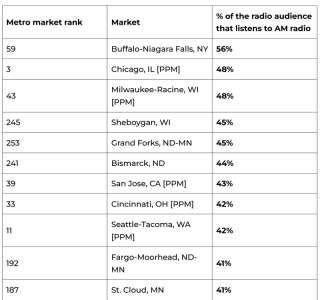Cumulus' Pierre Bouvard has compiled a listing of the markets with the greatest number of people listening to AM radio stations.

 www.westwoodone.com
www.westwoodone.com
Here is a summary:

This listing differs from what is often seen, which is the total share of listening to AM stations. This is a cume based analysis, which means that during a month, a rather large percentage of people listen for "a moment" to an AM station. The share-based data we normally see is based on "how much of the total actual listening during a time period goes to AM stations.
So, it seems that a lot of very random and occasional listening goes to AM, but on a day-in, day-out basis, not much total time is given to AM stations.
This

New Nielsen Study: 141 Local Markets Where AM Radio Is Listened To By At Least 20% Of The Radio Audience | Westwood One
Recently, Ford made a fast decision to recommit to AM radio in its vehicles. Now attention turns to other automakers who need to follow Ford’s lead on ensuring AM radio’s role in the car dashboard. Now, Nielsen is releasing a deeper dive on the vitality of AM radio in local metro markets.
Here is a summary:
- 82,346,800 Americans listen to AM radio monthly
- One out of three American AM/FM radio listeners are reached monthly by AM radio
- 57% of the AM radio audience listens to News/Talk stations, the very outlets that Americans turn to in times of crisis and breaking local news

This listing differs from what is often seen, which is the total share of listening to AM stations. This is a cume based analysis, which means that during a month, a rather large percentage of people listen for "a moment" to an AM station. The share-based data we normally see is based on "how much of the total actual listening during a time period goes to AM stations.
So, it seems that a lot of very random and occasional listening goes to AM, but on a day-in, day-out basis, not much total time is given to AM stations.
This
Last edited:

